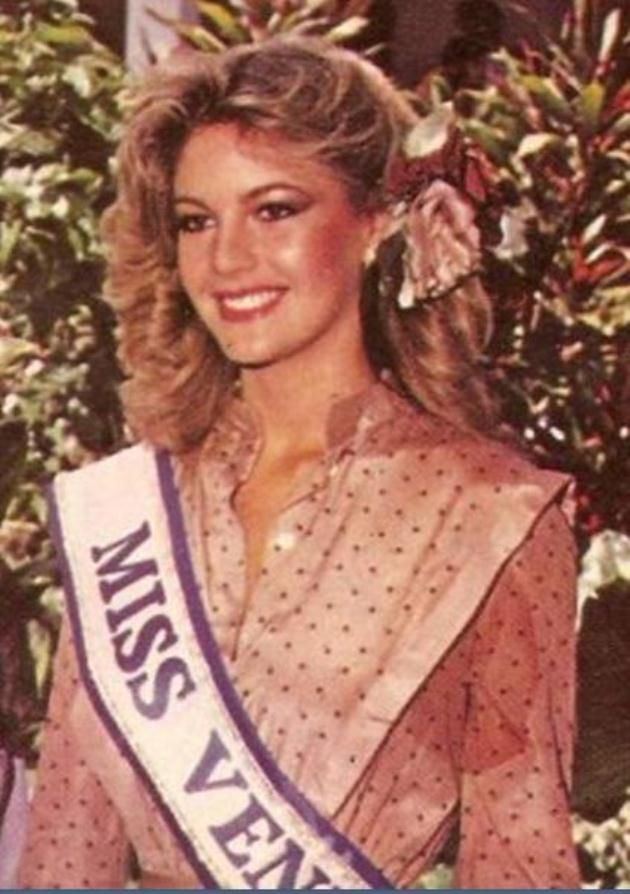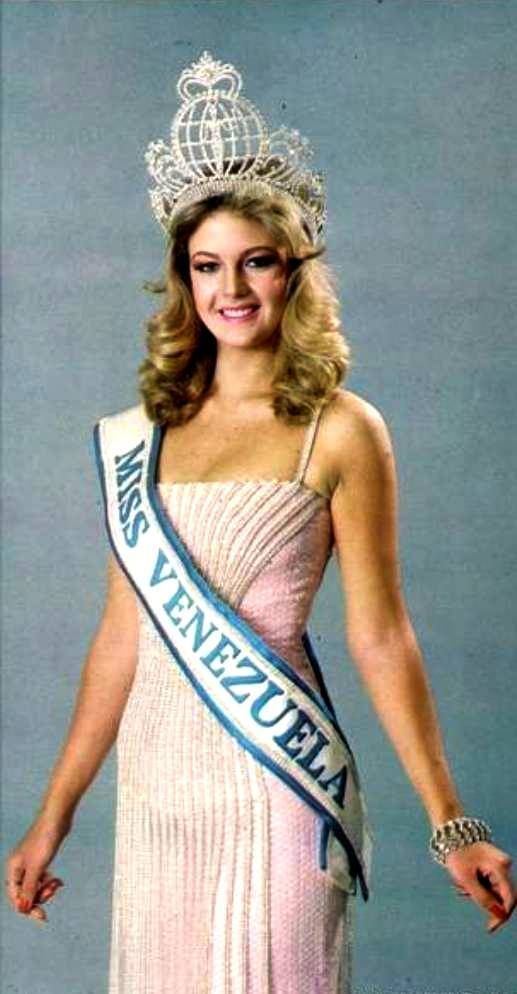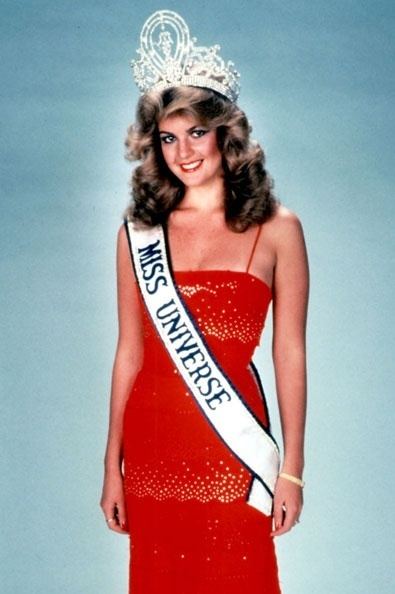Hair color Blonde Height 1.81 m Parents Carlos Sáez | Weight 59.2 kg (131 lb) Eye color Light Brown Spouse Serafín García (m. 2006) Siblings Eduardo Saez | |
 | ||
Full Name Irene Lailin Sáez Conde Title(s) Miss Venezuela 1981(Winner)Miss Universe Venezuela 1981(Winner)Miss Confraternidad Sudamericana(Winner) Similar Maritza Sayalero, Bárbara Palacios, Pilín León, Dayana Mendoza, Stefanía Fernández | ||
Irene Lailin Sáez Conde (born 13 December 1961 in Caracas, Venezuela) is a Venezuelan politician and beauty queen who was crowned Miss Universe 1981. She has been a model, was the mayor of Chacao (a municipality of Caracas), Governor of the state of Nueva Esparta and a former presidential candidate.
Contents
- Early life and education
- 1981 1989 Pageant wins and early political roles
- 1990 1997 Mayor of Chacao
- 1998 Presidential campaign
- 1999 2016 Governor of Nueva Esparta and boards
- Personal life
- References

Early life and education

Irene Lailin Sáez Conde was born on December 13, 1961 in Caracas, Venezuela. She graduated from the Central University of Venezuela.
1981-1989: Pageant wins and early political roles

Early in her career, Sáez was named Queen of Club Campestre Los Cortijos for three years in a row. Sáez was crowned Miss Venezuela 1981 and later, crowned Miss Universe 1981 at the 30th annual pageant in New York City at the age of 19. After spending a year traveling the world as Miss Universe, Sáez had studied political science at the Central University of Venezuela, and then served successfully a year as Venezuela's cultural representative to the United Nations expanding the international contacts developed into the realm of culture and diplomacy.
1990-1997: Mayor of Chacao

In the early 1990s Sáez turned to electoral politics and a week after the November 1992 coup attempt, led by Hugo Chavez, was elected mayor of Chacao Municipality, the wealthiest of the five municipalities of Caracas. Unbeknownst to Sáez at the time her political future would continue to be tied to Chavez's meteoric rise in the OPEC nation. In office as mayor of Chacao Municipality, Sáez tackled Chacao's high crime rate by professionalising the municipal police force, with university graduates as officers, higher pay, new police vehicles, and a variety of mobility devices (including roller skates and mountain bikes) allowing the police to move around quickly. Crime fell dramatically as a result of her innovative ideas. Without political experience or an established party machine, Sáez was content to delegate on experts, and "hired top-notch administrators and listened to their advice about everything from setting the budget to running public services."
By the time of the next election in December 1995, Sáez was so popular that she didn't bother to campaign, and only one independent candidate opposed her. Her 96% share of the vote was the highest in Venezuela's democratic history. The Times of London ranked her 83rd in its list of the 100 most powerful women in the world, and presidential rumors multiplied. Yet her ability to defeat political opponents without actively campaigning left Sáez vulnerable to bad advice during a much more competitive presidential run in 1998.

In 1997, she was awarded the Distinguished Achievement Award at the Miss Universe Pageant, a recently created prize of the Miss Universe Organization. She made her acceptance speech in both English and Spanish. Sáez was received in the International Airport Simón Bolívar by former president of Venezuela, Luis Herrera Campins and he gave her a chain of gold for her victory in Miss Universe.
1998: Presidential campaign
Sáez kept her distance from mainstream parties for as long as she could, and in 1997 formed the Integrated Representation of New Hope (IRENE) Party as a launch pad for her eventual run in the December 1998 presidential elections. In the final poll of the year in December 1997 she reached almost 70% support - just one year prior to the presidential elections.
However, despite spending millions of dollars on publicity and public adoration, Sáez fell below 15% within six months, as the public became increasingly skeptical of her readiness for the presidency and she lost credibility as an anti-establishment candidate after accepting the endorsement of COPEI. An invitation analysts now see as a political trap for a candidate ahead of her times.
Sáez won the internal COPEI primary election with 62.7% of the vote, against Eduardo Fernandez's 35.7%, at an extraordinary convention with 1,555 COPEI delegates taking place at a Caracas hotel. An endorsement earned after COPEI realized their original male candidate was unable to win. Its leaders ascertained their best bet to remain competitive nationally was replace him with the charismatic yet independent Irene Sáez. Transforming her into the first independent and female candidate supported by a major political party for the presidency of Venezuela.
Sáez brought to national politics the voice of a vast majority of Venezuelans disenchanted with politics as usual wrapped in the familiar sophistication of a global beauty queen with ties to the elite class. Because of her physical attractiveness and ability to speak in public newspapers like "El Nacional" described her television appearances as "Reaganesque". To make herself more politically familiar Sáez adopted Argentina's Eva Perón's hair style and fiery language of social revolution. Her strong speech preceded Hugo Chavez's as she was a presidential candidate for years before him.
Observers argue Chavez usurped the essence of Sáez political message and because of his military background and revolutionary credentials, after a failed coup against former president Carlos Andres Pérez and serving a prison term, became a more credible anti-establishment candidate for the poor masses demanding radical social change. While at the beginning her beauty, charisma and sophistication opened the doors of national politics, at the end these same qualities assured victory to the rough and aggressive male military leader, Hugo Chavez, that would give Venezuelans the radical change they had demanded vociferously on the streets of Caracas, during "El Caracazo".
Sáez ran on a platform of ending corruption, reducing bureaucracy and refinancing public debt. Her campaign slogan was "a revolution is possible". One of the factors, if not the main one, in her quick political demise was the rise of the radical Hugo Chávez, whose message promised a much more direct challenge to the establishment, including a constitutional assembly to write a new constitution. In contrast, Irene Sáez "still spoke like a beauty queen anxious to avoid offending anybody in any way in anyplace," and led some to speak of the presidential race as a polarizing competition between "the Beauty and the Beast".
At the same time, Sáez's late 1997 misstep in Chacao of banning kissing in public plazas planned to generate free media publicity backfired helping raise doubts about whether her success in the small, exclusive and wealthy Chacao (Caracas' Beverly Hills) could translate to the presidency. By August the Radical Cause Party withdrew its backing, saying that she had "lost her status as an independent". Political insiders assumed correctly Chavez's incendiary rhetoric against the oligarchy to be more effective in preventing a true revolution than Sáez soft-power idealism could be.
After all it was COPEI former president, Rafael Caldera, who pardoned Hugo Chavez for the attempted coup against Carlos Andrés Pérez, from the opposing Democratic Action Party, making possible his eventual ascendance to power. Considered a betrayal of the Punto Fijo Pact that allowed Venezuela to simply rotate power among a small politically connected male elite. Chavez had no direct connection to Venezuela's ruling class besides Caldera's pardon, while Sáez was born, raised and supported by it.
Shortly before election day, COPEI abandoned her in favor of endorsing Henrique Salas Römer. Ultimately she finished a distant third with 2.8% of the vote. So what many had considered a "marriage of convenience" between Sáez, the leading presidential candidate for the previous six years according to national polls, and COPEI ended up with her being literally "abandoned at the altar" just prior to the presidential elections. By eclipsing Irene Sáez's rising political star the reign of Hugo Chavez began in Venezuela.
1999-2016: Governor of Nueva Esparta and boards
Soon after the 1998 presidential election, Sáez was elected Governor of the state of Nueva Esparta, in an election made necessary by the January 1999 death in office of Rafael Tovar. She won overwhelmingly with more than 70% of the votes, defeating the candidate of Democratic Action. She served as governor of the state until 2000, stepping down when she became pregnant, denying rumors that she was pushed aside by Chávez. In 2003 she was named to the board of directors of the Colonial BancGroup, south Florida region.
Personal life
Sáez married American television producer and duPont chemical heir Darryl duPont in 1982. The couple later divorced, and Sáez remarried and had a son (born in 2000). After divorcing again, she later moved to the United States to live in Miami, Florida. Saez and her current husband have a son together.
